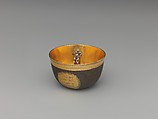Beaker
Hungarian, Úrvölogy (formerly Herrengrund)
Not on view
This beaker, and a similar one in the museum’s collection, 2010.110.67, is in tumbler form with a gilded lip above punched snakeskin decoration. Each show a silver figure of a miner seated on a column rising from the center of the bowl. The figures are made of silver that can be polished. When the bowl was filled with wine the tiny statuette’s image would be reflected on the surface of the “golden” beverage, the color of which was intensified by the gilded interior. Copper vessels in this form were popular souvenirs from Herrengrund, at that time in Northern Hungary, now in present-day Slovakia, extolling the seemingly magical qualities of the water in the region, which has unusually high concentrations of copper sulphate. Iron scraps left in pools of water did not actually transform into copper, but collected on their surface considerable amounts of pure copper precipitate drawn out of the water through a natural chemical reaction. The beaker is inscribed in two cartouches, “Before I was hard iron; the clear pure water changed me into copper within a few hours in Herrengrund.” These objects were a local curiosity, bought by visitors as souvenirs and offered at fairs throughout Central and Southeast Europe.
Literature
European Sculpture and Works of Art. Sale cat., Sotheby’s, London, July 5, 1990, no. 221.
Judit H. Kolba. Hungarian Silver: The Nicolas M. Salgo Collection. London, 1996, p. 136, no. 114.
References
Eugen von Philippovich. Kuriostäten, Antiquitäten. Braunschweig, 1966, pp. 199–206. (See fig. 136 for a similar example.)
Rainer Slotta. "Herrengrunder Gefässe." In Meisterwerke in Bergbaulicher Kunst vom 13. bis 19. Jahrhundert, pp. 602–9. Exh. cat. Deutsches Bergbau Museum, Bochum, and Schloss Cappenberg. Bochum, 1990.
[Wolfram Koeppe 2015]
Due to rights restrictions, this image cannot be enlarged, viewed at full screen, or downloaded.

